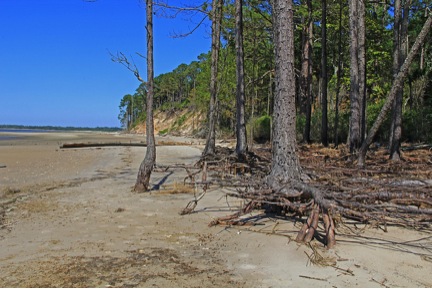Ecological Implications of Mangrove Forest Migration in the Southeastern U.S.

Currently, the U.S. Gulf of Mexico and southern Atlantic coast are comprised of various coastal ecosystems, including salt marshes and mangrove forests. Previous research has found that whether some of these coastal areas are salt marshes or mangrove forests depends heavily on precipitation and winter temperatures (Osland, 2013). As winter temperatures increase and freeze events grow milder, mangrove forests could significantly expand in the Gulf Coast. This project looks into how mangrove forest expansion and salt marsh displacement could affect coastal wetland soil processes and the coast’s ability to handle sea-level rise and carbon storage. Project leader Michael Osland from the USGS National Wetlands Research Center in Lafayette, Louisiana, tells us about his project:
1. What are you currently working on?
I’m currently working on various projects that examine the ecological implications of climate change within coastal wetland ecosystems along the Gulf of Mexico. In many ways, the Gulf of Mexico is one of the most interesting places in the world to study these effects because: (1) coastal wetlands are very abundant and important to the region; and (2) some of the world’s most dramatic coastal wetland transitions are found in the Gulf of Mexico. Coastal wetland ecosystems in the Gulf of Mexico are diverse, ranging from mangrove forests in south Florida to expansive salt marshes in the northern Gulf of Mexico to hypersaline tidal flats without vegetation in south Texas. Climatic drivers play a very important role in determining which species are present where. A large portion of my research program is dedicated to evaluating the importance of climatic drivers like rainfall and winter temperature extremes. In addition to supporting fish and wildlife, coastal wetlands store carbon, retain nutrients, maintain coastal food webs, support fisheries, and provide recreational and tourism opportunities. So, investigating how climate change affects these ecosystems is important to Gulf Coast communities.
One of my most interesting projects is focused on the effects of winter climate change upon mangroves and salt marshes in the region. With funding from the Southeast Climate Science Center, I’ve been working with a team that has been studying the effects of winter climate change upon coastal wetlands. Small changes in the intensity, duration, and frequency of extreme winter temperature could result in the poleward migration of mangrove forests at the expense of salt marshes. Salt marshes in Texas, Louisiana, and parts of Florida are especially vulnerable to mangrove expansion. Since 1989, we haven’t had a major freeze along the Gulf, and since that time, mangroves have been expanding into salt marshes in parts of Texas, Louisiana, and Florida.
2. Have you had a personal experience that brought the consequences of climate change impacts in coastal areas home to you?
Living near the coast makes you appreciate how dynamic and powerful the ocean is. Although I haven’t personally been affected by large hurricanes, I’ve seen the relatively dramatic effects of tropical storms and extreme tides. Tropical storms typically leave visible debris lines along the coast, and these lines can be found at high elevations. Observations like these make one realize the tremendous consequences of sea level rise and more intense storms for low-lying coastal communities as well as for coastal ecosystems.
3. About what consequence of changing coastal ecosystems are you most concerned?
Coastal ecosystems are being affected by multiple stressors including sea level rise, eutrophication, direct conversion, coastal development, and reduced freshwater inflows. I’m concerned that due to these combined stressors, future generations won’t be able to experience and appreciate these ecosystems in the same way that we do today.
4. What is the most unexpected finding you have come across in your research?
One unexpected finding is that the ecological implications of mangrove expansion into salt marsh depends in part upon rainfall regimes. We’ve found that in drier parts of the Gulf of Mexico (i.e., south Texas), the effects of mangrove expansion and forest development upon carbon storage are higher than in wetter parts of the Gulf of Mexico (e.g., Louisiana or Florida). I wasn’t expecting that result. But in hindsight, this finding fits in pretty well with results from research in terrestrial grassland ecosystems.
5. What do you think most people misunderstand about climate change and the coast?
Although most people recognize the potential effects of sea level rise, I think many people (scientists included) don’t fully appreciate the importance of climatic drivers like rainfall and extreme winter temperatures. In the Gulf of Mexico, these macroclimatic drivers play an important role and should be included in long-term planning and management efforts.
Read more about the project here: https://secasc.ncsu.edu/projects/ecological-implications-of-mangrove-forest-migration-in-the-southeastern-united-states/
- Categories:
